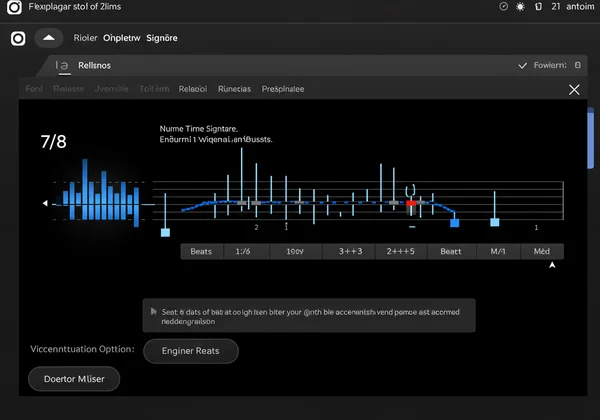أتقن التواقيع الزمنية المعقدة باستخدام المترونوم عبر الإنترنت
هل تشعر أنك عالق في النمط المألوف لميزان 4/4؟ حان الوقت لتتحرر! افتح عالمًا من الإمكانيات الإيقاعية وتغلب على التواقيع الزمنية الصعبة مثل 5/4، 7/8، أو 6/8. يكشف هذا الدليل كيف يمكن لمترونوم قوي وقابل للتخصيص عبر الإنترنت أن يُحدث ثورة في ممارستك، مما يساعدك على فهم الإيقاعات المعقدة واستيعابها وإتقانها بثقة لا تتزعزع. هل أنت مستعد لتحسين إيقاعك حقًا، حتى عندما لا تكون النبضة واضحة؟ الدقة والأداة المثالية هما مفتاحك للنجاح.
تتطلب هذه الرحلة إلى المنطقة الإيقاعية المتقدمة أكثر من مجرد مسار نقرات بسيط. أنت بحاجة إلى أداة تتكيف مع احتياجاتك، مما يسمح لك بتحليل هذه الأنماط المعقدة واستيعابها والشعور بها في النهاية. سنستكشف كيف توفر ميزات المترونوم الخاص بنا عبر الإنترنت المنصة المثالية لمواجهة هذه التحديات. استعد لتوسيع مفرداتك الموسيقية و ابدأ تدريبك بثقة.

فهم التواقيع الزمنية المعقدة والفردية
قبل الغوص في التدريب، من الضروري فهم ما يجعل التوقيع الزمني "معقدًا" أو "فرديًا". بينما تتمتع المقاييس القياسية مثل 4/4 أو 3/4 بإحساس مباشر ومتماثل، تقدم المقاييس الفردية والمعقدة تجمعات غير متماثلة تخلق توترًا وتدفقًا إيقاعيًا فريدًا. فهم هذا الأساس هو الخطوة الأولى نحو إتقانها.
ما هي التواقيع الزمنية المعقدة ولماذا هي مهمة؟
يخبرك التوقيع الزمني بشيئين: يشير الرقم العلوي إلى عدد النبضات في الميزان، ويشير الرقم السفلي إلى نوع النوتة التي تحصل على نبضة واحدة. في التواقيع الزمنية المعقدة أو الفردية، يكون الرقم العلوي عادةً رقمًا فرديًا مثل 5 أو 7، مما يخلق نمطًا لا ينقسم بدقة إلى مجموعات من اثنين أو ثلاثة. على سبيل المثال، يحتوي ميزان 7/8 على سبع نبضات من نوتة الثمن في الميزان الواحد.
تعتبر هذه المقاييس مهمة لأنها العمود الفقري الإيقاعي للعديد من الأنواع الموسيقية، من الروك التقدمي والجاز فيوجن إلى الموسيقى الكلاسيكية البلقانية والهندية التقليدية. يفتح تعلم العزف في المقاييس الفردية لغة موسيقية أكثر ثراءً وتنوعًا. إنه يتحدى ساعتك الداخلية، ويحسن مهارات التقسيم الفرعي لديك، ويجعلك في النهاية موسيقيًا أكثر مرونة وقدرة على التكيف.
تفكيك المقاييس الفردية الشائعة: 5/4، 7/8، 6/8، والمزيد
يكمن سر الشعور بهذه المقاييس في تقسيمها إلى مجموعات أصغر وأسهل في الفهم من اثنين وثلاثة. يسعى دماغك بشكل طبيعي إلى أنماط بسيطة، ويجعل تقسيم المقاييس المعقدة تبدو أقل ترويعًا. يعتبر مترونوم التوقيع الزمني المرن أمرًا بالغ الأهمية لهذه العملية.
إليك كيفية الشعور بالمقاييس الشائعة غالبًا:
- ميزان 5/4: يشتهر هذا الميزان من مقطوعات مثل "تيك فايف" لديف بروبيك. يُشعر به عادةً كمجموعة من 3 نبضات تليها 2 نبضة (3+2) أو العكس (2+3). يمكنك عدها كـ 1-2-3-1-2.
- ميزان 7/8: عنصر أساسي في الموسيقى التقدمية والعالمية، يمكن تجميع 7/8 بعدة طرق، مثل 2+2+3، 2+3+2، أو 3+2+2. يحدد نمط النبرة الإيقاع الفريد الخاص به.
- ميزان 6/8: على الرغم من أنه ليس ميزانًا "فرديًا"، إلا أن 6/8 هو ميزان "مركب". يحتوي على ست نوتات ثمن ولكنه يُشعر به بنبضتين قويتين، تتكون كل منهما من ثلاث نوتات ثمن (إحساس "واحد-و-آه، اثنان-و-آه"). هذا يميزه عن ميزان 3/4، الذي يحتوي على ثلاث نبضات مميزة.
إعداد المترونوم الخاص بك عبر الإنترنت للتحديات الإيقاعية
النظرية شيء، لكن الممارسة هي حيث تُصقل المهارة. لن يفي المترونوم العام الذي يقدم نقرات 4/4 فقط بالغرض لهذه التحديات الإيقاعية. أنت بحاجة إلى أداة يمكن تكييفها مع الهيكل المحدد لكل ميزان فردي. تم تصميم منصتنا بدقة لهذا النوع من العمل المفصل.
تخصيص التواقيع الزمنية على المترونوم الخاص بنا عبر الإنترنت
الخطوة الأولى هي تهيئة المترونوم الخاص بك ليتوافق مع التوقيع الزمني الذي تتدرب عليه. على المترونوم القابل للتخصيص في صفحتنا الرئيسية، يمكنك بسهولة ضبط عدد النبضات في الميزان. إذا كنت تعمل على ميزان 7/8، فما عليك سوى ضبط المترونوم على 7 نبضات واختيار نوتة الثمن كالنبضة الأساسية.
يضمن هذا الإعداد حصولك على نقرة متسقة لكل نبضة في الميزان. يوفر المؤشر المرئي على الشاشة طبقة إضافية من التغذية الراجعة، مما يساعدك على رؤية النبضة بينما تسمعها. هذا الاتصال السمعي البصري حيوي لاستيعاب الأنماط المعقدة وتطوير توقيت موسيقي قوي.

الاستفادة من النبرات للوضوح في المقاييس المركبة وغير المتماثلة
هنا يبرز المترونوم المتقدم حقًا. فمجرد وجود سبع نقرات لميزان 7/8 لا يكفي؛ أنت بحاجة إلى الشعور بالتجمعات الداخلية. يتيح لك المترونوم المجاني الخاص بنا إضافة نبرات على نبضات محددة، وهو المفتاح لفك شفرة إحساس أي ميزان فردي.
على سبيل المثال، للتدرب على ميزان 7/8 بنمط 2+2+3، ستقوم بتعيين نبرات على النبضة 1، والنبضة 3، والنبضة 5. سيصدر المترونوم صوتًا كالتالي: نقرة-نقرة-نقرة-نقرة-نقرة-نقرة-نقرة. تعمل هذه الميزة على تدريب أذنك على سماع الهيكل الأساسي، وتحويل سلسلة النقرات المربكة إلى إيقاع موسيقي ملموس. يمكنك تجربة أنماط نبرات مختلفة لإتقان جميع الاختلافات الإيقاعية لميزان واحد.
تمارين عملية لإتقان الإيقاعات الصعبة
بعد تهيئة أداتك بشكل صحيح، حان الوقت للبدء في العمل. تم تصميم التمارين التالية لبناء أساسك الإيقاعي من الألف إلى الياء. تذكر أن تبدأ ببطء وتُعطي الأولوية للدقة على السرعة. يمكنك دائمًا استخدام أداة BPM الخاصة بنا لزيادة الإيقاع تدريجيًا كلما اكتسبت الثقة.
نهج التقسيم الفرعي: تفكيك النبضات المعقدة
إذا كنت تواجه صعوبة في الشعور بالنبضات الرئيسية لميزان فردي، فركز على أصغر قيمة للنوتة - التقسيم الفرعي. بالنسبة لميزان 7/8، ستكون هذه نوتة الثمن. اضبط المترونوم الخاص بك على إيقاع مريح، مثل 120 نبضة في الدقيقة، وفكر في كل نقرة كنوتة ثمن.
أولاً، صفق أو انقر مع النقرات فقط للحصول على إحساس بالنبض الثابت. بعد ذلك، عد التجمعات بصوت عالٍ (على سبيل المثال، "1-2، 1-2، 1-2-3") مع الاستمرار في التصفيق. يربط هذا التمرين الشعور الجسدي للإيقاع بهيكله الرياضي، مما يبني فهمًا عميقًا وبديهيًا.
بناء السرعة والطلاقة: زيادات تدريجية في الإيقاع للمقاييس الفردية
بمجرد أن تتمكن من عزف نمط بدقة بإيقاع بطيء، حان الوقت لبناء السرعة. لا تقم بقفزات كبيرة في الإيقاع، حيث يمكن أن يؤدي ذلك إلى عزف غير دقيق وأخطاء متأصلة. النهج المنهجي أكثر فعالية بكثير.
ابدأ بإيقاع بطيء حيث يمكنك العزف بشكل مثالي، على سبيل المثال، باستخدام إعداد مترونوم 60 نبضة في الدقيقة. اعزف المقطع أو السلم الموسيقي عدة مرات دون أخطاء. ثم، زد السرعة بمقدار 2-4 نبضة في الدقيقة فقط. كرر العملية. تتحدى هذه الزيادة التدريجية ذاكرتك العضلية وسرعة المعالجة دون إرهاقها، مما يؤدي إلى عزف نظيف وواثق بإيقاعات أسرع. هذا مبدأ أساسي للممارسة الإيقاعية الفعالة.

تدريب الأذن والتصور: استيعاب الأنماط غير المنتظمة
الهدف النهائي هو استيعاب هذه الإيقاعات جيدًا لدرجة أنك لم تعد بحاجة إلى المترونوم كعكاز. لاختبار ساعتك الداخلية، جرب تمرين "المقاييس الصامتة". اضبط المترونوم عبر الإنترنت للعزف لميزان واحد ثم ليصمت للميزان التالي. خلال الميزان الصامت، استمر في العزف وحاول الهبوط بدقة على النبضة الأولى عندما تعود النقرة.
تقنية قوية أخرى هي التصور. بينما ينقر المترونوم، تصور تجمعات النبضات في ذهنك. شاهد نمط "3+2" لميزان 5/4 أو نبضة "2+2+3" لميزان 7/8. يعزز هذا التدريب العقلي المسارات العصبية المرتبطة بالإيقاع، مما يجعله يبدو طبيعيًا مثل ميزان 4/4.
أطلق العنان لإمكانياتك الإيقاعية باستخدام المترونوم الخاص بنا عبر الإنترنت
إن إتقان التواقيع الزمنية المعقدة والفردية هو مسعى صعب ولكنه مجزٍ بشكل لا يصدق. إنه يفتح آفاقًا إبداعية جديدة ويرفع من مستوى مهارتك الموسيقية إلى مستوى احترافي. تتطلب الرحلة الصبر، والممارسة المنهجية، والأهم من ذلك، الأدوات المناسبة للوظيفة.
من خلال تفكيك المقاييس المعقدة إلى تجمعات بسيطة، والاستفادة من النبرات القابلة للتخصيص، واتباع روتين تدريب منظم، يمكنك التغلب على أي إيقاع. يوفر المترونوم الخاص بنا عبر الإنترنت أداة الإيقاع الخاصة بنا المجانية والقوية والمتاحة المصممة لدعمك في كل خطوة. إنه أكثر من مجرد حافظ للوقت؛ إنه بيئة تدريب شاملة. فماذا تنتظر؟ رحلتك إلى الإتقان الإيقاعي تبدأ الآن. توجه إلى المترونوم الخاص بنا عبر الإنترنت اليوم واكتشف مدى سهولة الممارسة المتقدمة!

الأسئلة الشائعة حول الإيقاعات المعقدة والمترونوم
ماذا يعني BPM في الموسيقى، وكيف يرتبط بالتواقيع الزمنية المعقدة؟
BPM تعني "نبضة في الدقيقة"، وهي تقيس سرعة القطعة الموسيقية أو وتيرتها. في أي توقيع زمني، بسيط أو معقد، يحدد BPM مدى سرعة النبض الأساسي. على سبيل المثال، في ميزان 7/8 بسرعة 140 نبضة في الدقيقة، سيكون هناك 140 نبضة من نوتة الثمن في كل دقيقة.
كيف يمكن للمترونوم أن يحسن إيقاعي عند التدرب على المقاييس الفردية؟
يوفر المترونوم مرجعًا موضوعيًا وثابتًا للوقت، وهو أمر بالغ الأهمية لاستيعاب الأنماط الإيقاعية غير المألوفة. بالنسبة للمقاييس الفردية، تتيح لك أداة قابلة للتخصيص مثل أداتنا تعيين نبرات تحدد تجمعات النبضات الداخلية (على سبيل المثال، 3+2 في ميزان 5/4)، مما يدرب دماغك على الشعور بالنبض غير المتماثل بشكل صحيح.
هل المترونوم المجاني الخاص بنا فعال حقًا للتدريب المتقدم؟
نعم، بالتأكيد. منصتنا هي مترونوم مجاني بالكامل عبر الإنترنت بدون رسوم خفية أو اشتراكات. إنه يوفر ميزات متقدمة مثل التواقيع الزمنية القابلة للتخصيص، وتقسيمات فرعية للنبضات، ونبرات، مما يجعله أداة احترافية مناسبة للموسيقيين من جميع المستويات، من المبتدئين إلى المحترفين المتمرسين. يمكنك البدء في استخدامه الآن على مترونوم مجاني هنا.
ما هو معدل BPM الجيد للتدرب عند تعلم الإيقاعات المعقدة لأول مرة؟
عند تعلم أي إيقاع جديد أو معقد، فإن أفضل معدل BPM هو معدل بطيء. ابدأ بإيقاع حيث يمكنك العزف الجزء بشكل مثالي وبدون توتر، عادة ما بين 50 و 70 نبضة في الدقيقة. الهدف هو بناء الدقة والذاكرة العضلية أولاً. ستأتي السرعة بشكل طبيعي مع الممارسة المتسقة والمنهجية.